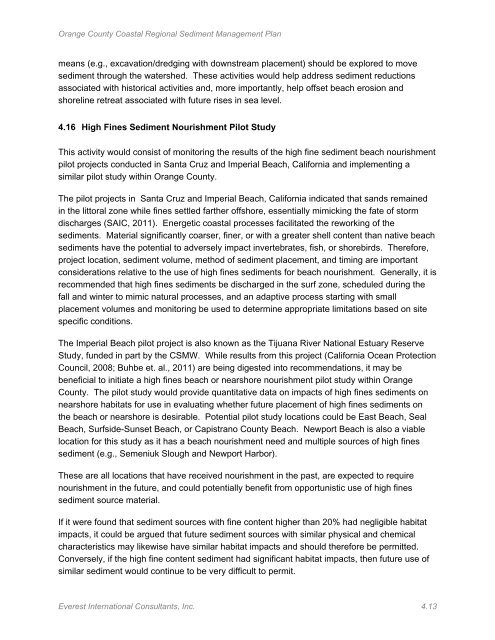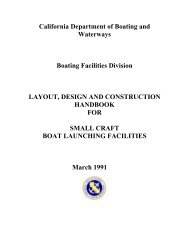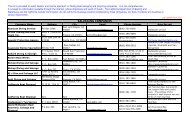EVEREST June, 2013 - California Department of Boating and ...
EVEREST June, 2013 - California Department of Boating and ...
EVEREST June, 2013 - California Department of Boating and ...
Create successful ePaper yourself
Turn your PDF publications into a flip-book with our unique Google optimized e-Paper software.
Orange County Coastal Regional Sediment Management Plan<br />
means (e.g., excavation/dredging with downstream placement) should be explored to move<br />
sediment through the watershed. These activities would help address sediment reductions<br />
associated with historical activities <strong>and</strong>, more importantly, help <strong>of</strong>fset beach erosion <strong>and</strong><br />
shoreline retreat associated with future rises in sea level.<br />
4.16 High Fines Sediment Nourishment Pilot Study<br />
This activity would consist <strong>of</strong> monitoring the results <strong>of</strong> the high fine sediment beach nourishment<br />
pilot projects conducted in Santa Cruz <strong>and</strong> Imperial Beach, <strong>California</strong> <strong>and</strong> implementing a<br />
similar pilot study within Orange County.<br />
The pilot projects in Santa Cruz <strong>and</strong> Imperial Beach, <strong>California</strong> indicated that s<strong>and</strong>s remained<br />
in the littoral zone while fines settled farther <strong>of</strong>fshore, essentially mimicking the fate <strong>of</strong> storm<br />
discharges (SAIC, 2011). Energetic coastal processes facilitated the reworking <strong>of</strong> the<br />
sediments. Material significantly coarser, finer, or with a greater shell content than native beach<br />
sediments have the potential to adversely impact invertebrates, fish, or shorebirds. Therefore,<br />
project location, sediment volume, method <strong>of</strong> sediment placement, <strong>and</strong> timing are important<br />
considerations relative to the use <strong>of</strong> high fines sediments for beach nourishment. Generally, it is<br />
recommended that high fines sediments be discharged in the surf zone, scheduled during the<br />
fall <strong>and</strong> winter to mimic natural processes, <strong>and</strong> an adaptive process starting with small<br />
placement volumes <strong>and</strong> monitoring be used to determine appropriate limitations based on site<br />
specific conditions.<br />
The Imperial Beach pilot project is also known as the Tijuana River National Estuary Reserve<br />
Study, funded in part by the CSMW. While results from this project (<strong>California</strong> Ocean Protection<br />
Council, 2008; Buhbe et. al., 2011) are being digested into recommendations, it may be<br />
beneficial to initiate a high fines beach or nearshore nourishment pilot study within Orange<br />
County. The pilot study would provide quantitative data on impacts <strong>of</strong> high fines sediments on<br />
nearshore habitats for use in evaluating whether future placement <strong>of</strong> high fines sediments on<br />
the beach or nearshore is desirable. Potential pilot study locations could be East Beach, Seal<br />
Beach, Surfside-Sunset Beach, or Capistrano County Beach. Newport Beach is also a viable<br />
location for this study as it has a beach nourishment need <strong>and</strong> multiple sources <strong>of</strong> high fines<br />
sediment (e.g., Semeniuk Slough <strong>and</strong> Newport Harbor).<br />
These are all locations that have received nourishment in the past, are expected to require<br />
nourishment in the future, <strong>and</strong> could potentially benefit from opportunistic use <strong>of</strong> high fines<br />
sediment source material.<br />
If it were found that sediment sources with fine content higher than 20% had negligible habitat<br />
impacts, it could be argued that future sediment sources with similar physical <strong>and</strong> chemical<br />
characteristics may likewise have similar habitat impacts <strong>and</strong> should therefore be permitted.<br />
Conversely, if the high fine content sediment had significant habitat impacts, then future use <strong>of</strong><br />
similar sediment would continue to be very difficult to permit.<br />
Everest International Consultants, Inc. 4.13




